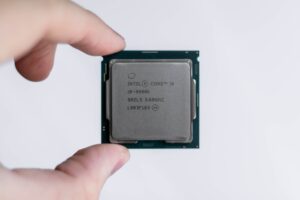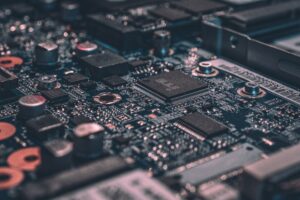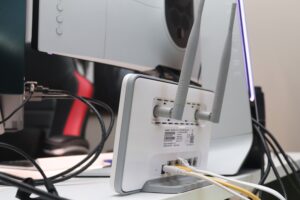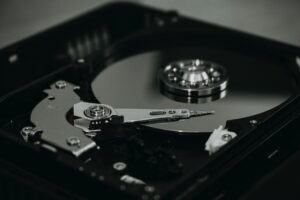A computer works by transforming the simple language of binary codes into the complex, multifaceted digital operations we rely on daily. From streaming your favorite show to crunching numbers for your work report, it’s a marvel of modern technology. But what exactly goes on behind the screen?
Your computer is a box filled with mysteries, turning your clicks and keystrokes into actions, images, and sounds. This blog post is your ticket to understanding the wizardry behind not just traditional computers but all computational devices. We’re peeling back the layers of complexity to reveal how a computer works, in terms that everyone can understand.
The Brain of the Computer – The Processor
Imagine a bustling city where every task, no matter how big or small, is coordinated flawlessly. This city is like the Central Processing Unit (CPU) of your computer, a masterpiece of engineering that orchestrates the entirety of how a PC works. The CPU, often referred to as the brain of the computer, is a critical part of the computer’s system architecture and is where the magic of how a computer works begins.
A Symphony of Transistors
So how does a computer work using a CPU? Comprising millions of tiny transistors, the CPU is a marvel of modern engineering. These transitions act as microscopic switches, rapidly flipping between the on and off states, representing the binary language of ones and zeros. This rapid flipping allows the CPU to perform its many calculations and process instructions at incredible speeds, often measured in gigahertz (GHz).
Every application, from simple note-taking to complex video editing, relies on the CPU’s power to process its instructions efficiently. In essence, CPU operations are the heart of your computer, a hub of digital activity that turns your inputs into tangible outputs, marking the modern computing experience.
Speaking in Binary – The Language of Computers

Binary is the simplest yet profound language at the core of how any PC works. A computer works by representing data with just two states: 1 and 0. These binary digits, or ‘bits’, are the function of digital logic, aligning perfectly with the on and off states of electronic circuits.
The power of binary is in its exponential growth of representation with each added bit. Text, images, and sounds are all translated into binary codes. For instance, in ASCII (American Standard Code for Information Interchange), the letter ‘A’ is represented as 01000001. In images, binary codes determine pixel colors and brightness, while in audio, they represent different sound waves.
Binary in Computer Operations
A computer works by performing operations using these binary instructions or machine code. Though basic, these instructions (when executed rapidly,) enable complex tasks like running applications and processing digital media. Computer memory, such as RAM (Random Access Memory), also relies on binary to store and process data.
Binary’s simplicity is the key to its power in computing, allowing for the elegant and efficient computing processes that underpin the complex world of computer technology. Understanding binary gives us a deeper appreciation for the intricacies of the devices that are integral to our modern lives.
Input and Output – Communication Channels
Understanding computer functioning and how PCs work is incomplete without delving into its communication channels: the input and output devices. These are the bridges between the user and the machine, facilitating a two-way conversation. If you’re experiencing issues with your computer not showing up on a network, especially in Windows 10, check out our network guide which offers practical solutions. Or, for on-site assistance with your wireless network setup, call our experienced techs today.
Explore Wireless Network Setup Services
A computer works and interacts with us by utilizing input devices. Every keystroke, mouse click, and voice command is an input – a way of ‘telling’ the computer what we want it to do. Each of these devices translates physical actions into digital signals that the computer can understand and process.
Decoding Outputs – How Computers Talk Back
On the flip side are output devices, which translate the computer’s digital language into a form we can perceive. The most familiar output device is the monitor, which displays text, images, and videos. Speakers and headphones convert digital audio signals into sound waves. Printers materialize digital documents into physical paper forms. Even newer technologies, like VR headsets, serve as output devices, creating immersive visual and auditory environments.
Looking to enhance your computing experience with some new output devices? The Geeks on Site online store is your ultimate destination for high-quality printers, monitors, and much more. Shop today!
The Seamless Conversation Between User and Machine
This ongoing exchange of input and output is crucial to how a computer works. It’s how a PC works to become more than just a machine – it becomes a tool for creativity, productivity, and connection. As technology evolves, these communication channels are becoming more seamless, intuitive, and integrated into our daily lives.
A Symphony of Hardware and Software: Unveiling The Inner Workings
A computer is a machine composed of many computer hardware and software components, each playing a unique role. A computer works by receiving data through an input unit based on the instructions it is given and after it processes the data, it sends it back through an output device. But how does this come together to explain how your PC works?
The input devices of a computer can depend on the type of computer we are dealing with, but most typically we will find a mouse, keyboard, scanner or even applications (software) installed on the computer. Once the data has been received, the central processing unit (CPU) along with the help of other computer components, takes over and completes the information processing. Once the data is ready, it will be sent back through an output device which can be a monitor, speaker, printer, ports, etc.
To better imagine how a computer works, knowing what’s inside will make it easier. Let’s dive into some of the main components of a computer:
- CPU – The CPU or Central Processing Unit is considered the most important component in a computer and for good reason. It handles most operations that make it function, by processing instructions and giving signals out to other components. The CPU is the main bridge between all the computer’s major parts.

- Motherboard – There is no acronym for this component but without it, there can’t be a computer. The computer works by using the Motherboard as the home for all other components, allows them to communicate with each other and gives them power in order to function. There are components that don’t require a physical connection to the Motherboard in order to work, such as Bluetooth or Wi-Fi but, if there is no connection or signal whatsoever, the computer won’t know it’s there.

- Video and Sound Cards – Two components which help the user interact with the computer. Although one can use a computer with a missing sound card, it’s not really possible to use it without a video card. A computer works by using the sound card to play sound through a speaker, while a video card is used to send images on the screen. Without these, it would be like looking at an empty monitor.
- Network Adapter – Even though it is not actually required to operate the computer, the Network adapter improves the user’s experience as it provides access to the Internet. Modern computers with operating systems such as Windows 10 will not offer the user all of its features without an Internet connection.

Memory and Storage: The Art of Remembering
To truly understand how a computer or PC works, it’s essential to understand the concepts of memory and storage. They are the pillars that support the vast array of tasks a computer performs, from running applications to storing your precious photos. While they may seem similar, memory and storage serve distinctly different yet complementary roles in the computer’s ecosystem.
These memory management and storage functions include several key components, each serving a unique and vital role in how a computer works.
- RAM (Random Access Memory) — Random Access Memory, or RAM for short, is a computer component where data used by the operating system and software applications store data so that the CPU can process them quickly. Everything stored on RAM is lost if the computer is shut off. Depending on the applications you use, there is typically a maximum limit of RAM you will need for the computer to function properly.
If you’re having trouble retrieving your important data, or want to make sure you never experience data loss again, Geeks on Site’s computer data recovery and backup services can help. Get in touch today.
Data Recovery and Backup Services
- Disk Drives
- HDD (Hard Disk Drive) — Also known as Hard Drive, this computer mechanism is where photos, apps, documents and such are kept. The traditional storage workhorse of computers, HDDs use magnetic storage to store and retrieve digital information. They offer large storage capacities and are cost-effective, but are slower compared to newer technologies.

- SDD (Solid State Drive) — Representing a significant leap in storage technology, SSDs use flash memory to store data. They are faster, more reliable, and less prone to physical shock compared to HDDs. Their speed significantly reduces boot and load times, enhancing overall system performance.
- HDD (Hard Disk Drive) — Also known as Hard Drive, this computer mechanism is where photos, apps, documents and such are kept. The traditional storage workhorse of computers, HDDs use magnetic storage to store and retrieve digital information. They offer large storage capacities and are cost-effective, but are slower compared to newer technologies.
- CD/DVD Drive — The CD/DVD drive, while less prevalent in modern computer designs, has been a staple in how a PC works to provide data storage and retrieval. These drives use optical media to read and write data. CDs and DVDs are used for various purposes, such as storing multimedia content, software, and backups. Despite being overshadowed by USB drives and cloud storage, they still hold relevance for specific uses and legacy systems.
Each memory component, from the fleeting but rapid RAM to the more permanent solutions like HDDs and SSDs, plays a critical role in how a computer works, giving it the ability to store, process, and retrieve data. The CD/DVD drives, though fading in prominence, complete the spectrum of data manipulation and storage options available in a computer system.
The Internet – Expanding the Horizon
The Internet has transformed computers from isolated workstations into gateways to a global network. This vast, interconnected web of information is a crucial aspect of how your computer works, expanding the capabilities of individual computers exponentially.
The Journey of Data
At its core, the Internet is a network of computers connected through a complex system of cables, wireless signals, and satellite links. Every time you browse a website, send an email, or stream a video, your computer is sending and receiving data packets across this network. These packets travel at incredible speeds, bouncing from server to server, sometimes across continents, to reach their destination.
Finding that your computer is slow or taking too long to restart? Check out our blog on some effective solutions!
The Web of Connectivity
The Internet is a colossal network connecting millions of computers worldwide. But how does your computer work using this incredible network? It starts with an Internet Service Provider (ISP), which gives your computer access to the Internet. This connection can be wired, like with an Ethernet cable, or wireless, like WiFi. Check out our detailed WiFi troubleshooting guide to help you connect to WiFi on your computer seamlessly. Once connected, your PC works by using a unique address – an IP (Internet Protocol) address – to identify itself and communicate with other computers.
The Endless Journey of Discovery
Understanding how a computer works opens up a world of technology and innovation. How a PC works is a journey that starts with the simple binary language of ones and zeros and stretches out to the vast expanse of the Internet. If you’re looking to enhance your computer skills, our Computer Tutor Home Training blog provides valuable information on personalized training.
Every component, every bit of data, and every line of code plays a part in the grand orchestra that is how a computer works. So the next time you power on your device, take a moment to appreciate the intricate dance of technology happening right beneath your fingertips.
Ensure Your Computer is Working at its Best with the Help of Geeks on Site
If you are having trouble understanding how your PC works, or using any of your computer’s internal or external components, please do not hesitate to contact Geeks on Site. Our experienced techs can help you with any computer issues and explain exactly how your computer’s components work. Our techs are often able to fix issues remotely by walking you through a few steps to give them access to your computer.
So, whether you’re facing a memory overload, a storage hiccup, or any other tech challenge, remember that Geeks on Site is just a call away. Let’s make sure your digital life runs as smoothly and efficiently as the fascinating inner workings of a computer itself.
